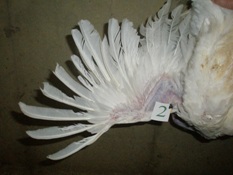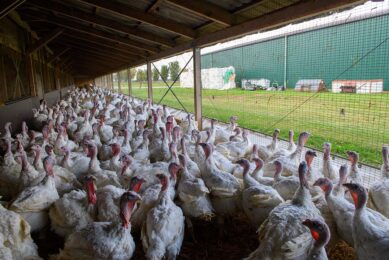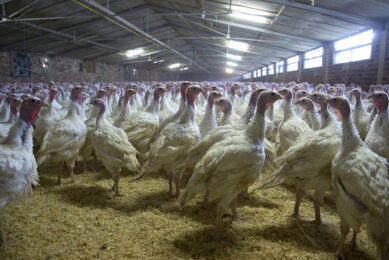Productive turkeys have a full feather pack

Birds are unique in nature for many reasons but especially for their feathers. Feathers serve multiple functions including protection, warmth, display, and the ability to fly. Logically, a well feathered turkey will be a productive bird.
By Hybrid Turkeys, Kitchener, ON, Canada
Feathers are replaced several times during a bird’s life and follow consistent, predictable patterns. Since certain nutrients are required for feather growth and replacement, the quality of feathers and their rate of growth can be affected by factors such as nutrient intake, body composition, day length, age and sexual maturity. Highlighted here are feathers in the domestic turkey and how monitoring their status may be used as a management tool for welfare and production.
Feather growth
Historically, feathers have been categorised into six different classes: contour; down; semi-plume; filo-plume; bristle, and powder-down. Contour feathers are the vaned feathers that cover the bird’s body. The largest of the contour feathers are the flight feathers that extend beyond the body (wings and tail) and function in flight (Welty, 1975).
Historically, feathers have been categorised into six different classes: contour; down; semi-plume; filo-plume; bristle, and powder-down. Contour feathers are the vaned feathers that cover the bird’s body. The largest of the contour feathers are the flight feathers that extend beyond the body (wings and tail) and function in flight (Welty, 1975).
Feathers are attached to the bird’s skin in the dermal and epidermal layers. All feathers are anchored within a feather follicle that appears (in the turkey embryo) around Day 10 of incubation. All follicles develop during incubation and serve the bird for life. Feathers appear on Day 11 of incubation and contain keratin that is distinct for feathers, scales, beaks and claws. A typical feather grows until it reaches a definite size, then it stops and the cells in the feather follicle become dormant until the feather is molted. Normally, at the proper time for molting, reactivated cells in the follicle grow a new feather that pushes out the old feather above it. Consequently, feathers grow from the base, not the tip. If a feather is accidentally removed, the germ cells in the follicle can reactivate to replace it.
Feather replacement
Feathers grow at different rates, depending upon the species, the bird’s age, its diet and health. Other factors in the rate of feather growth include the part of the body where the feather is located, time of year and day length (night-time growth is slowest). For birds that nest on the ground, including turkeys with precocial young (parents bring no food), feather growth is the most rapid and the soonest completed.
Feathers grow at different rates, depending upon the species, the bird’s age, its diet and health. Other factors in the rate of feather growth include the part of the body where the feather is located, time of year and day length (night-time growth is slowest). For birds that nest on the ground, including turkeys with precocial young (parents bring no food), feather growth is the most rapid and the soonest completed.
In most birds, feathers are distributed in scattered patches on the body, called “feather tracts”. Within a tract, feathers are arranged in definite patterns, often in rows. Though species vary, most birds have eight different feather tracts. The wing and tail tracts carry the contour feathers responsible for flight. The largest and most distal feathers are clustered together on the wing flipper (hand) and are called the primary wing feathers. Most turkeys have 10 primaries and they have been assigned the Roman Numerals one to ten (I-X) from innermost to the wing tip. The secondary wing feathers are large quill feathers along the forearm (ulna). They vary in number by species. Turkeys normally have 18 and (numbered 1-18) from the wrist to the elbow.
Molting of feathers
As feathers become worn, they loosen in their follicles and drop out, pushed out by the already growing new feather underneath. The prime function of a molt is the replacement of worn feathers. Adult birds normally molt and renew their feathers once a year, usually after the natural breeding season. In young birds plumage is regularly replaced as they reach adult size.
As feathers become worn, they loosen in their follicles and drop out, pushed out by the already growing new feather underneath. The prime function of a molt is the replacement of worn feathers. Adult birds normally molt and renew their feathers once a year, usually after the natural breeding season. In young birds plumage is regularly replaced as they reach adult size.
The natural functions of feathers, protection and flight, are indispensible. Therefore, the replacement of feathers is arranged in such a pattern to preserve both functions. The energy demand of feather growth is heavy and usually does not occur during times of reproduction (or in wild birds, during migration). Feathers are not replaced all at once, but with a definite, bilaterally symmetrical pattern. The most common molting pattern of a primary wing feather molt is called “descending” in which feathers drop out beginning with number one (I) at the wrist joint, proceeding in sequence outward and is complete when the 10th (X) feather is replaced.
The first secondary feathers to molt are those at the two ends of the arm (the wrist and the shoulder, 1 and 18) and the last to be replaced are in the centre of the forearm. Tail feathers molt centrifugally, or from the center outward.
Table 1 – Age at which primary wing feather is molted
Table 2 – Weeks for replaced feather to be fully-developed
The time interval between the loss of a feather and the complete growth of its replacement varies according to species, body condition, and environmental conditions. Primaries of the domestic chicken require 70-90 days for complete replacement. Poults hatch with natal down, which is replaced by juvenile plumage, followed by adult plumage.
Slow and fast growing
Individual hens of two different lines, Slow-Growing Line (SL) and Fast-Growing Line (FL), were observed in a study. Hens of each line were wing-tagged and housed in the same barn with their hatch mates, but restricted by fencing to one section of the barn to facilitate observations. Photos were taken weekly of the left wing on each hen to document primary wing feather replacement during rearing and conditioning. The left wing of each hen was extended to visually inspect the individual primary wing feathers and the hen’s identifying tag. Observations in this study confirm that the 1st primary feather is replaced during the 5th week of age under current conditions. Only two hens in this study replaced the 10th primary, one at Week 20 and the other at Week 28.
Individual hens of two different lines, Slow-Growing Line (SL) and Fast-Growing Line (FL), were observed in a study. Hens of each line were wing-tagged and housed in the same barn with their hatch mates, but restricted by fencing to one section of the barn to facilitate observations. Photos were taken weekly of the left wing on each hen to document primary wing feather replacement during rearing and conditioning. The left wing of each hen was extended to visually inspect the individual primary wing feathers and the hen’s identifying tag. Observations in this study confirm that the 1st primary feather is replaced during the 5th week of age under current conditions. Only two hens in this study replaced the 10th primary, one at Week 20 and the other at Week 28.
Indications
The most recent descriptions of feather development and molting are now decades old. Most research about turkey feathering was conducted with Broad Breasted Bronze turkeys and later comparisons were reported for the Beltsville White. Since that time, feather growth and replacement have not changed much with regard to anatomy and physiology.
The most recent descriptions of feather development and molting are now decades old. Most research about turkey feathering was conducted with Broad Breasted Bronze turkeys and later comparisons were reported for the Beltsville White. Since that time, feather growth and replacement have not changed much with regard to anatomy and physiology.
Similarly, selection for improved market traits in domestic birds has not changed the feather patterns or feather structure. But modern production practices, for example, may have an impact upon the rate at which feathers are replaced. While the time to completely replace a feather in wild birds can take between 30-45 days, domestic fowl in 1950 required up to 90 days for full replacement. Egg production lines in this study replaced primaries 1 through 5 in less than 49 days while hens of the faster growing lines replaced feathers in 28 days or less while exposed to 12 hours of light per day.
Restricting hens to only six hours of daylight per day in this study extended the time required to fully replace a feather to between 50 and 70 days. This supports previous reports that feather growth slows during the dark period each day. Early research indicates that the thyroid gland is involved with feather growth which would involve both metabolic rate and thermoregulation by the thyroid and exert an influence upon feather growth.
Effectiveness of management
Nutrition and nutrient absorption also demonstrate an effect upon feather quality in the literature. The presence of weak bands (stress bars) in the development of feathers may indicate enteric disturbances or a lack of essential nutrients for a period of hours during feather growth.
Nutrition and nutrient absorption also demonstrate an effect upon feather quality in the literature. The presence of weak bands (stress bars) in the development of feathers may indicate enteric disturbances or a lack of essential nutrients for a period of hours during feather growth.
Figure 1 – Common feather disruption on a turkey wing.
And finally, symmetry in feather replacement is expected. While inspecting the progress of feather replacement, the 5th primary on both wings should be replaced simultaneously. If asymmetry is reported, ensure that lighting intensity, spectrum and day length are each consistent, so that birds perceive photoperiod cues accurately.
Hens within each flock of turkeys always demonstrate variability in body weight, health status and sexual maturity. Feather growth is no exception. Feathering may vary between flocks and between seasons for every company and geographic location. Patterning the feather growth in hens may add another husbandry tool with which to compare the effectiveness of the management programme and may help improve the productivity of flocks conditioned for egg production.
MORE INFORMATION |
Join 31,000+ subscribers
Subscribe to our newsletter to stay updated about all the need-to-know content in the poultry sector, three times a week. Beheer
Beheer








 WP Admin
WP Admin  Bewerk bericht
Bewerk bericht